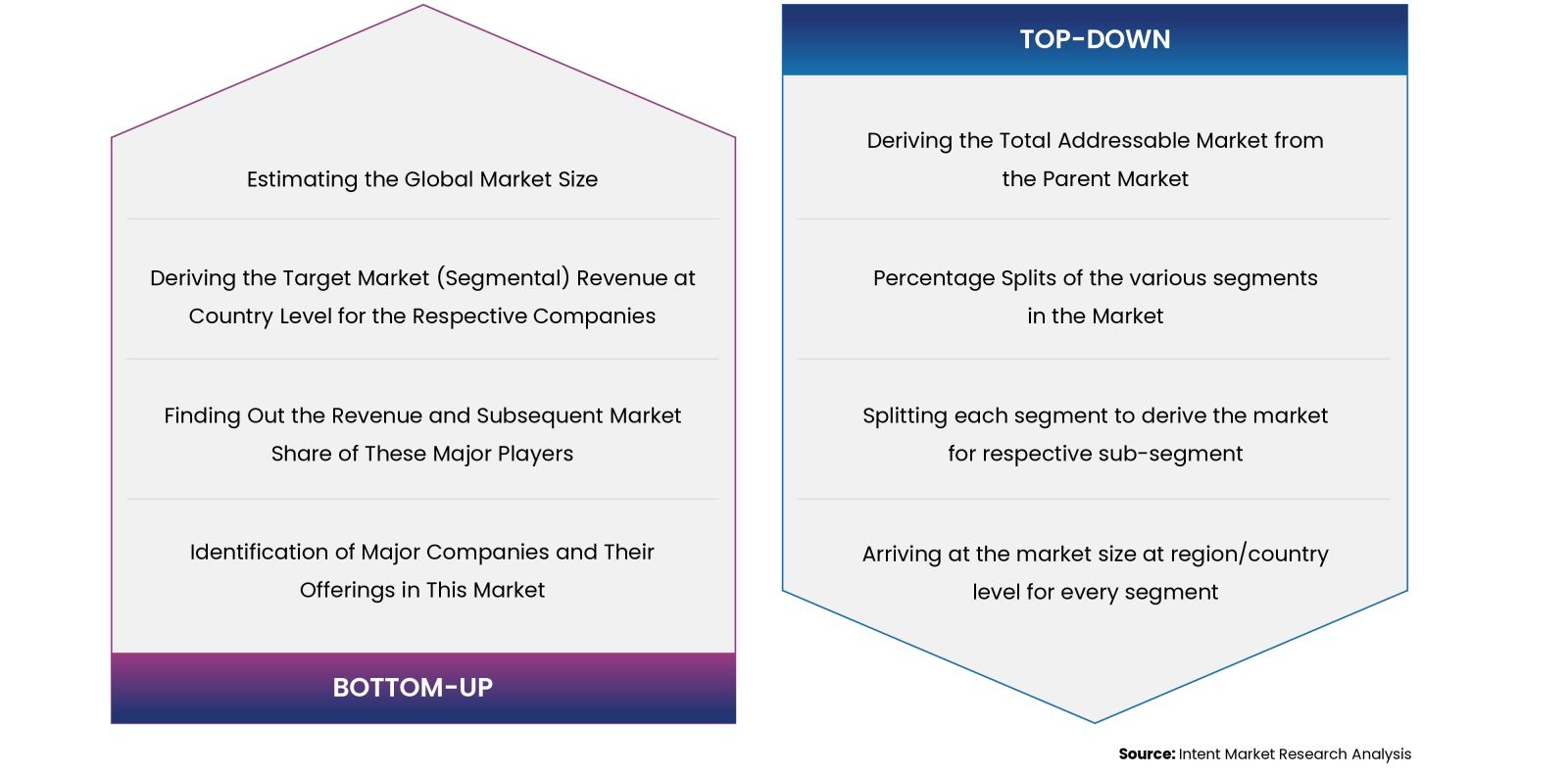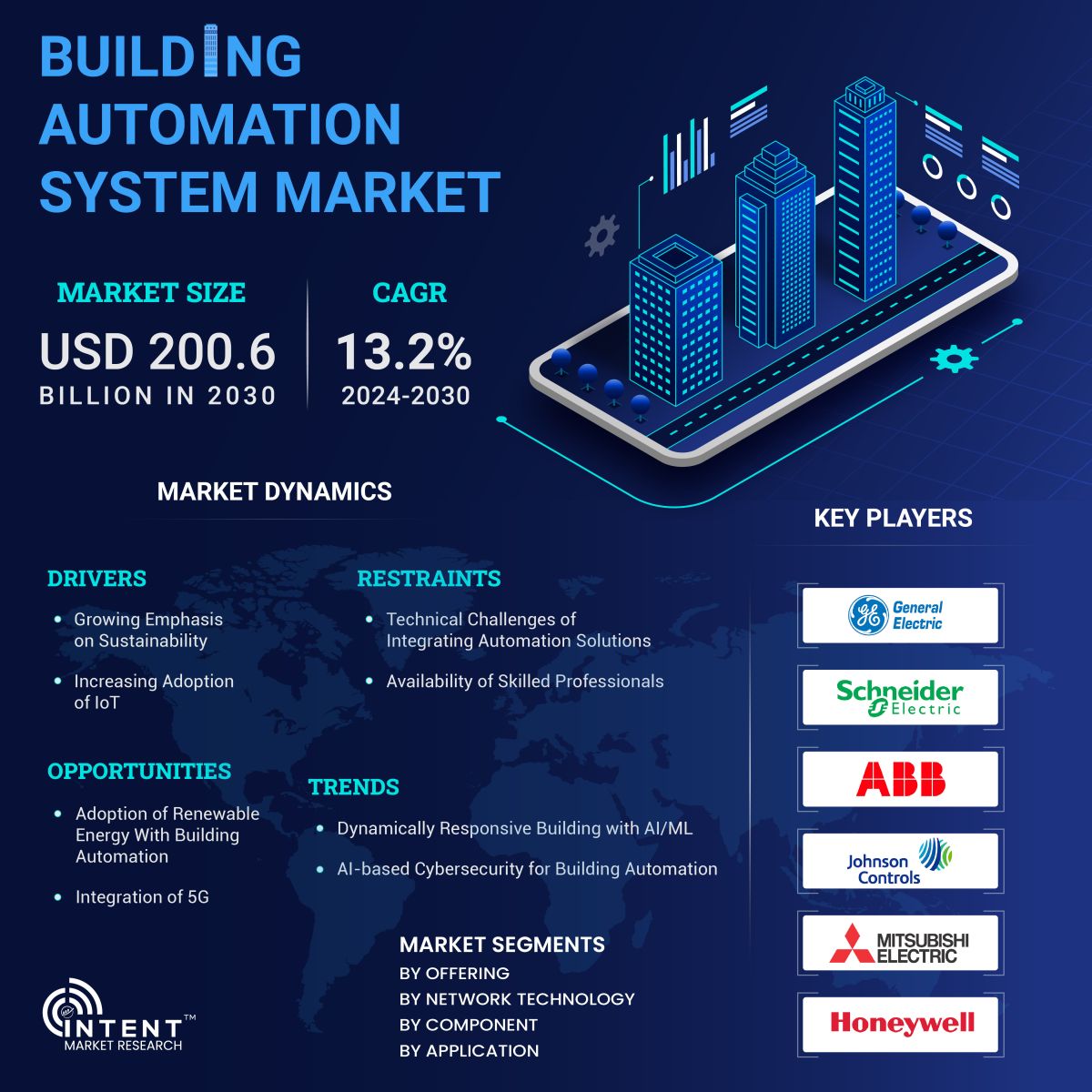The Building Automation System Market is expected to grow from USD 84.2 billion in 2023-e to USD 200.6 billion by 2030, at a CAGR of 13.2% during the forecast period. The building automation system market is a competitive market, the prominent players in the global market include ABB, Bosch, Emerson, General Electric, Honeywell, Hubbell, Johnson Controls, Mitsubishi Electric, Schneider Electric, Siemens, among others.
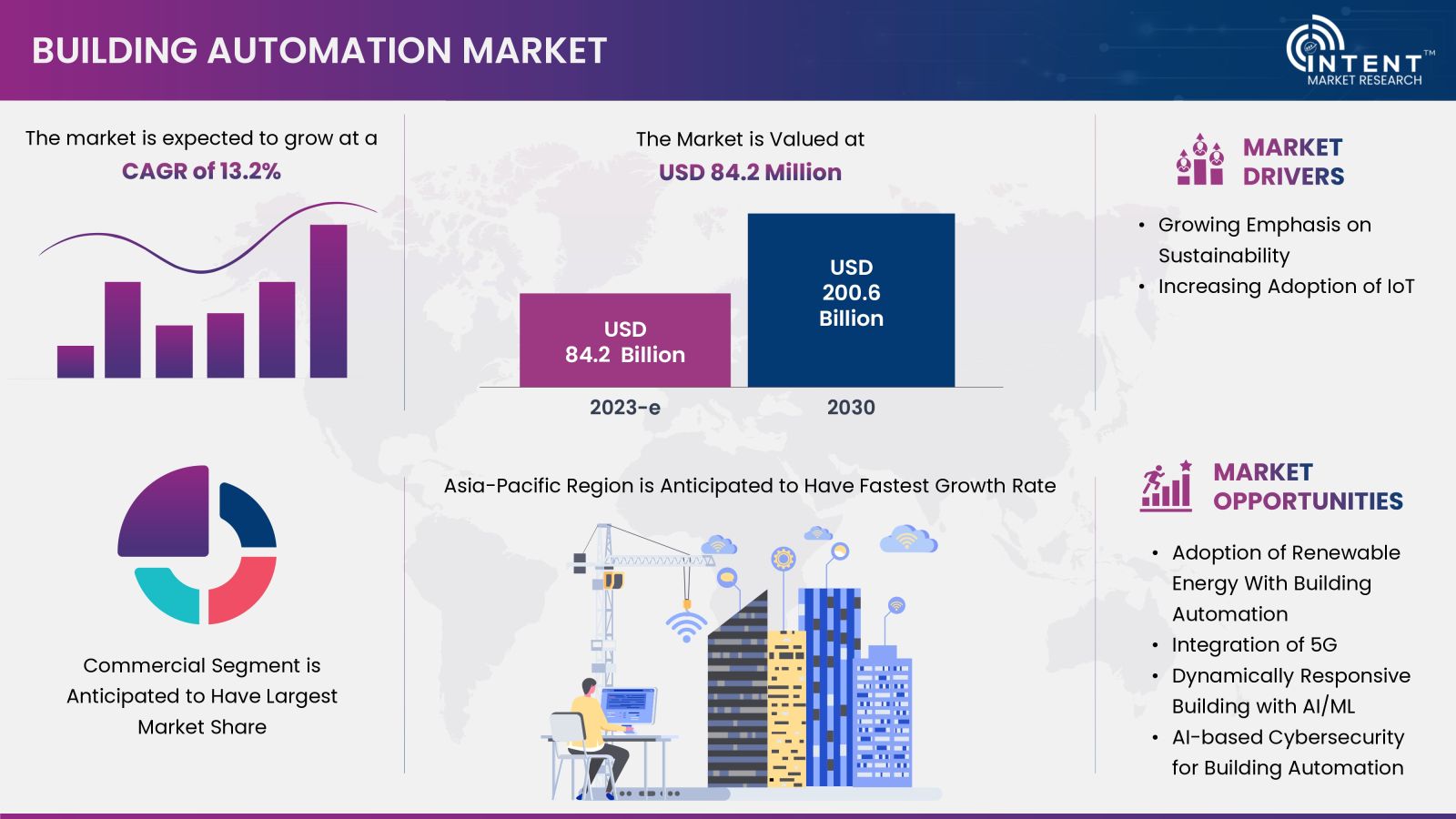
Click here to: Get FREE Sample Pages of this Report
The growth of this market is attributed to growing emphasis on sustainability from the government and private sector. However, technical challenges of integrating automation solutions and availability of skilled professionals are the major restraining factor for the market growth. Contrarily, the increasing growth of 5G and emphasis on renewable energy are expected to offer several growth opportunities to the market stakeholders. Conversely, lack of network standards may challenge the market growth in the coming years.
IoT Driving the Market Growth
IoT-powered building automation is offering several benefits for the eco-friendly operation of building. IoT plays a significant role in building automation by offering improved efficiency, reduction ion operational cost, and optimized usage of energy. It also allows more streamlined, seamless and integrated management of building automation. IoT enables single networking of various devices and systems of the building that can be controlled & monitored remotely.
IoT-connected sensors and devices in BAS allow for remote monitoring and control of building systems. Facility managers can access real-time data and control building functions remotely, providing greater flexibility and efficiency in managing building operations.
IoT devices generate vast amounts of data related to building operations, occupancy patterns, energy usage, and environmental conditions. This data can be leveraged through analytics to gain insights into building performance. BAS, integrated with IoT, enables data-driven decision-making for optimizing energy efficiency, predictive maintenance, and overall building management. A data gathered from IoT sensors can be utilized for predictive maintenance before the failure of any critical equipment or system used in building. Thereby, nullifying the probability of break-down or down-time. Thus, it helps to improve the productivity of businesses present in the building.
The implementation of IoT-driven BAS can lead to significant cost savings over time. Improved energy efficiency, reduced maintenance costs through predictive maintenance, and optimized operations contribute to a positive return on investment (ROI) for building owners and operators.
The convergence of IoT with building automation systems enhances the capabilities of BAS, making buildings smarter, more efficient, and user-friendly. As the demand for smart and connected buildings continues to rise, driven by the benefits of IoT, the market for building automation systems is expected to experience sustained growth.
Key Findings of the Building Automation System Market Study
Security & Access Control Has High Demand
The building automation system market is segmented into facility management, security & access control, fire protection system, energy management software, and BAS services. In 2023, security & access control accounted for the significant share of the market. Security & access control systems such as video surveillance and biometric system are in high demand from the end-users for authenticity of persons that are entering the building premises.
Wireless Expected to Register the Higher CAGR
The building automation system market is segmented into wired and wireless. Wired system are more reliable compared to wireless system. Also, in a changing environment, wired system are more resilient and shows more accurate results. However, wireless system are cost-effective than wired system.
Expected High Demand for Software in Coming Years
The building automation system market is segmented into: hardware, software. IoT sensors, actuators, cameras, etc. are some of the major hardware used in building automation. Computerized maintenance management system (CMMS), facility management software, computer-aided facility management (CAFM) software, integrated workplace management system (IWMS) and enterprise asset management (EAM) software are the major software used for building automation.
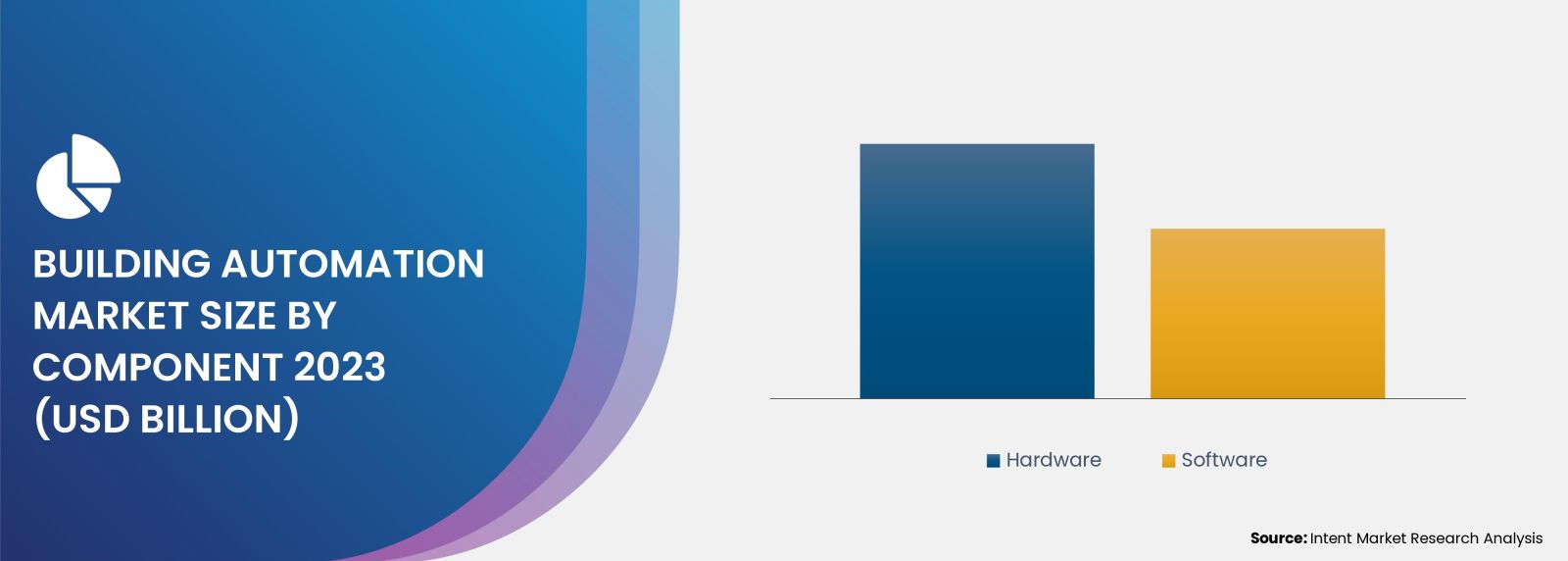
Commercial Buildings Segment to Record High Growth in Global BAS Market
Building automation system market is segmented into industrial, residential and commercial. Commercial segment is expected to drive the segmental growth during the forecast period. Increasing investment in smart building, higher adoption of IoT among small & medium commercial places and increasing emphasis on building security are the major factors driving the commercial segment growth.
Additionally, building automation in hospitals involves the integration of technology to efficiently manage and control various systems within the facility. This can include HVAC (Heating, Ventilation, and Air Conditioning), lighting, security, energy management, and other building systems. The goal is to enhance the overall functionality, safety, and energy efficiency of the hospital environment. Automation systems can regulate the temperature in different areas of the hospital, ensuring a comfortable environment for patients, staff, and visitors. Automation can monitor and control air quality, helping to maintain optimal conditions for patients and prevent the spread of infections.
Implementing building automation in hospitals requires careful planning, coordination, and consideration of the unique needs of healthcare facilities. It can lead to improved operational efficiency, cost savings, and a safer, more comfortable environment for patients and staff. Additionally, cybersecurity measures should be a priority to protect sensitive healthcare data and ensure the reliability of automated systems.
Asia-Pacific to Grow with the Highest CAGR
Asia-Pacific BAS market shows the significant market share in 2023. The growing adoption of IoT, increasing investment in smart factories, and strong backing from the government has provided the ideal opportunities for the market to grow in the region.
Asia-Pacific countries has been experiencing significant urbanization. Urban areas, including commercial and residential buildings, require efficient and smart infrastructure, driving the adoption of building automation systems to manage energy consumption, improve security, and enhance overall building efficiency. Many countries in the Asia-Pacific region are implementing regulations and initiatives to promote energy efficiency and sustainability. For instance, India has created its energy conservation building code (ECBC) to improve the energy efficiency in the new commercial buildings.
Additionally, India’s Bureau of Energy Efficiency (BEE) has also introduced a labeling programme for Net Zero Energy Buildings (NZEB) and Net Positive Energy Buildings (NPEB). It has widen the scope of the building labelling programme based on energy consumption.

Key players operating in the global building automation system market are ABB, Bosch, Emerson, General Electric, Honeywell, Hubbell, Johnson Controls, Mitsubishi Electric, Schneider Electric, Siemens, among others. The presence of several global and local players have significantly fragmented the market. However, to tap the potential of this growing market, market players have started adopting several strategies such as new product launch, to improve their market share.
Click here to: Get your custom research report today
Building Automation System Market Coverage
The report provides key insights into the building automation system market, and it focuses on technological developments, trends, and initiatives taken by the government and private players. It delves into market drivers, restraints, opportunities, and challenges that are impacting the market growth. It analyses key players as well as the competitive landscape within the global market.
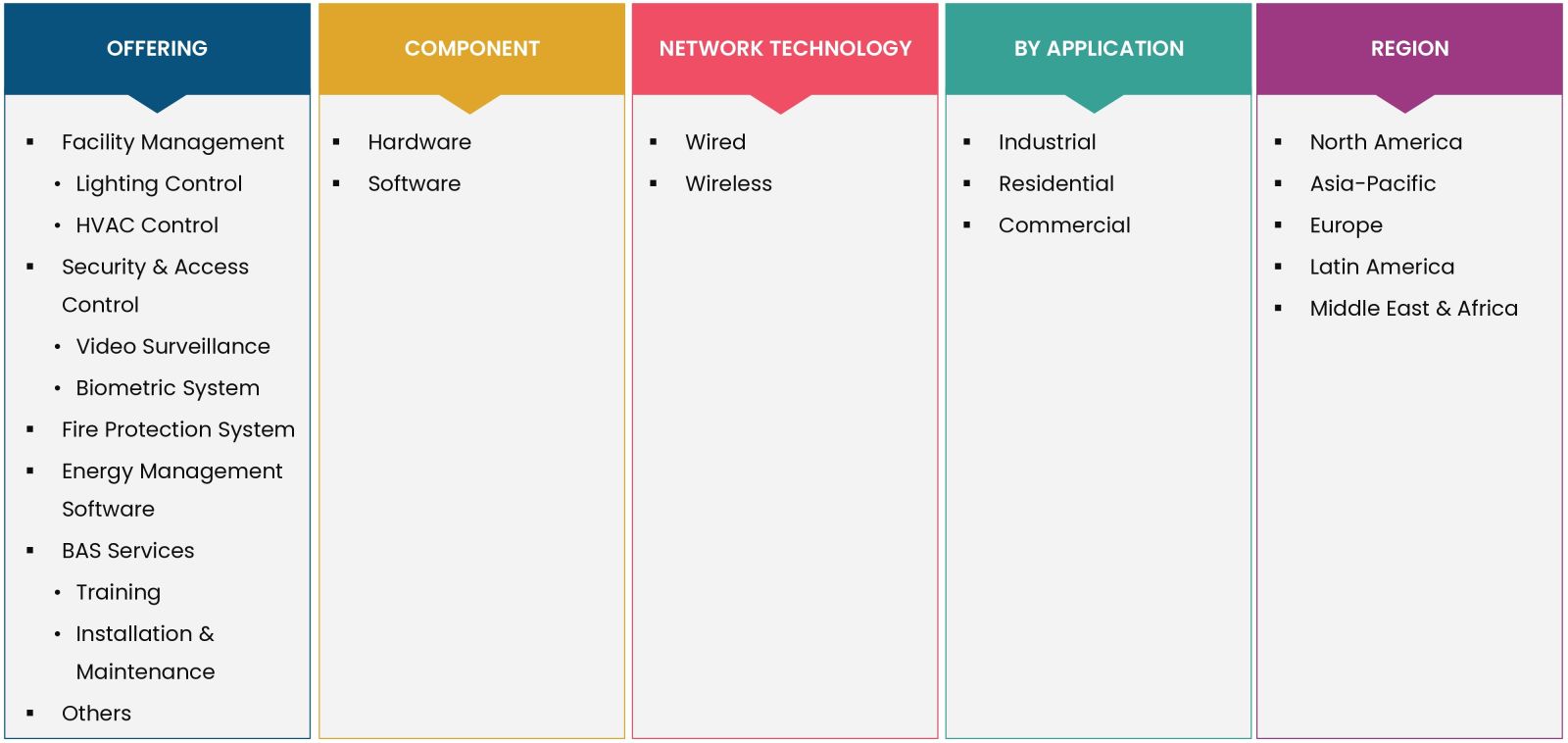
Report Scope
|
Report Features |
Description |
|
Market Size (2023-e) |
USD 84.2 billion |
|
Forecast Revenue (2030) |
USD 200.6 billion |
|
CAGR (2024-2030) |
13.2% |
|
Base Year for Estimation |
2023-e |
|
Historic Year |
2022 |
|
Forecast Period |
2024-2030 |
|
Report Coverage |
Market Forecast, Market Dynamics, Competitive Landscape, Recent Developments |
|
Segments Covered |
Building Automation System Market by Offering ((Facility Management (Lighting Control, HVAC Control), Security & Access Control (Video Surveillance, Biometric System), Fire Protection System, Energy Management Software, BAS Services (Training, Installation & Maintenance), Others)); By Network Technology (Wired, Wireless); By Component (Hardware, Software); By Application (Industrial, Residential, Commercial (Hospitals & Healthcare Clinics, Airports & Railway Stations, Supermarkets)) |
|
Regional Analysis |
North America (US, Canada), Europe (Germany, France, UK, Italy), Asia-Pacific (China, Japan, South Korea, India), Latin America and Middle East & Africa |
|
Competitive Landscape |
ABB, Bosch, Emerson, General Electric, Honeywell, Hubbell, Johnson Controls, Mitsubishi Electric, Schneider Electric, Siemens, among others |
|
Customization Scope |
Customization for segments, region/country-level will be provided. Moreover, additional customization can be done based on the requirements. |
|
Purchase Options |
We have three licenses to opt for: Single User License, Multi-User License (Up to 5 Users), Corporate Use License (Unlimited User and Printable PDF) |
|
1.Introduction |
|
1.1.Market Definition |
|
1.2.Scope of the Study |
|
1.3.Key Stakeholders of the Market |
|
2.Research Methodology |
|
2.1.Research Approach |
|
2.2.Data Collection |
|
2.3.Market Assessment |
|
2.4.Assumptions & Limitations for the Study |
|
3.Executive Summary |
|
4.Market Dynamics |
|
4.1.Drivers |
|
4.1.1.Growing Emphasis on Sustainability |
|
4.1.2.Increasing Adoption of IoT |
|
4.2.Restraints |
|
4.2.1.Technical Challenges of Integrating Automation Solutions |
|
4.2.2.Availability of Skilled Professionals |
|
4.3.Opportunities |
|
4.3.1.Adoption of Renewable Energy With Building Automation |
|
4.3.2.Integration of 5G |
|
4.4.Threats or Challenges |
|
4.4.1.Lack of Network Standard |
|
4.5.Trends |
|
4.5.1.Dynamically Responsive Building with AI/ML |
|
4.5.2.AI-based Cybersecurity for Building Automation |
|
5.Market Outlook |
|
5.1.Protocol Analysis |
|
5.2.Pricing Analysis |
|
5.3.PORTER’S Five Forces Analysis |
|
5.4.PESTLE Analysis |
|
5.5.Case Studies |
|
6.Market Size by Offering (Market Size and Forecast - USD billion, 2024 - 2030) |
|
6.1.Facility Management |
|
6.1.1.Lighting Control |
|
6.1.2.HVAC Control |
|
6.2.Security & Access Control |
|
6.2.1.Video Surveillance |
|
6.2.2.Biometric System |
|
6.3.Fire Protection System |
|
6.4.Energy Management Software |
|
6.5.BAS Services |
|
6.5.1.Training |
|
6.5.2.Installation & Maintenance |
|
6.6.Others |
|
7.Market Size by Component (Market Size and Forecast - USD billion, 2024 - 2030) |
|
7.1.Hardware |
|
7.2.Software |
|
8.Market Size by Network Technology (Market Size and Forecast - USD billion, 2024 - 2030) |
|
8.1.Wired |
|
8.2.Wireless |
|
9.Market Size by Application (Market Size and Forecast - USD billion, 2024 - 2030) |
|
9.1.Industrial |
|
9.2.Residential |
|
9.3.Commercial |
|
9.3.1.Hospitals & Healthcare Clinics |
|
9.3.2.Airports & Railway Stations |
|
9.3.3.Shopping Malls & Supermarkets |
|
9.3.4.Other Commercial Properties |
|
10.Regional Outlook (Market Size and Forecast - USD billion, 2024 - 2030) |
|
10.1. North America |
|
10.1.1. US |
|
10.1.1.1. US Market Outlook by Offering |
|
10.1.1.2. US Market Outlook by Component |
|
10.1.1.3. US Market Outlook by Network Technology |
|
10.1.1.4. US Market Outlook by Application |
|
Note: Similar Cross-segmentation for each country will be covered as shown above |
|
10.1.2. Canada |
|
10.2. Asia-Pacific |
|
10.2.1. China |
|
10.2.2. Japan |
|
10.2.3. South Korea |
|
10.2.4. India |
|
10.3. Europe |
|
10.3.1. UK |
|
10.3.2. Germany |
|
10.3.3. France |
|
10.3.4. Italy |
|
10.4. Latin America |
|
10.5. Middle East & Africa |
|
11.Competitive Landscape |
|
11.1. Market Share Analysis |
|
11.2. Key Market Growth Strategies |
|
11.3. Company Strategy Analysis |
|
11.4. Competitive Benchmarking |
|
12.Company Profile |
|
12.1. ABB |
|
12.2. Bosch |
|
12.3. Emerson |
|
12.4. General Electric |
|
12.5. Honeywell |
|
12.6. Hubbell |
|
12.7. Johnson Controls |
|
12.8. Mitsubishi Electric |
|
12.9. Schneider Electric |
|
12.10. Siemens |
|
13.Appendix |
Intent Market Research employs a rigorous methodology to minimize residual errors by carefully defining the scope, validating findings through primary research, and consistently updating our in-house database. This dynamic approach allows us to capture ongoing market fluctuations and adapt to evolving market uncertainties.
The research factors used in our methodology vary depending on the specific market being analysed. To begin with, we incorporate both demand and supply side information into our model to identify and address market gaps. Additionally, we also employ approaches such as Macro-indicator Analysis, Factor Analysis, Value Chain-based Sizing, and forecasting to further increase the accuracy of the numbers and validate the findings.
Research Approach
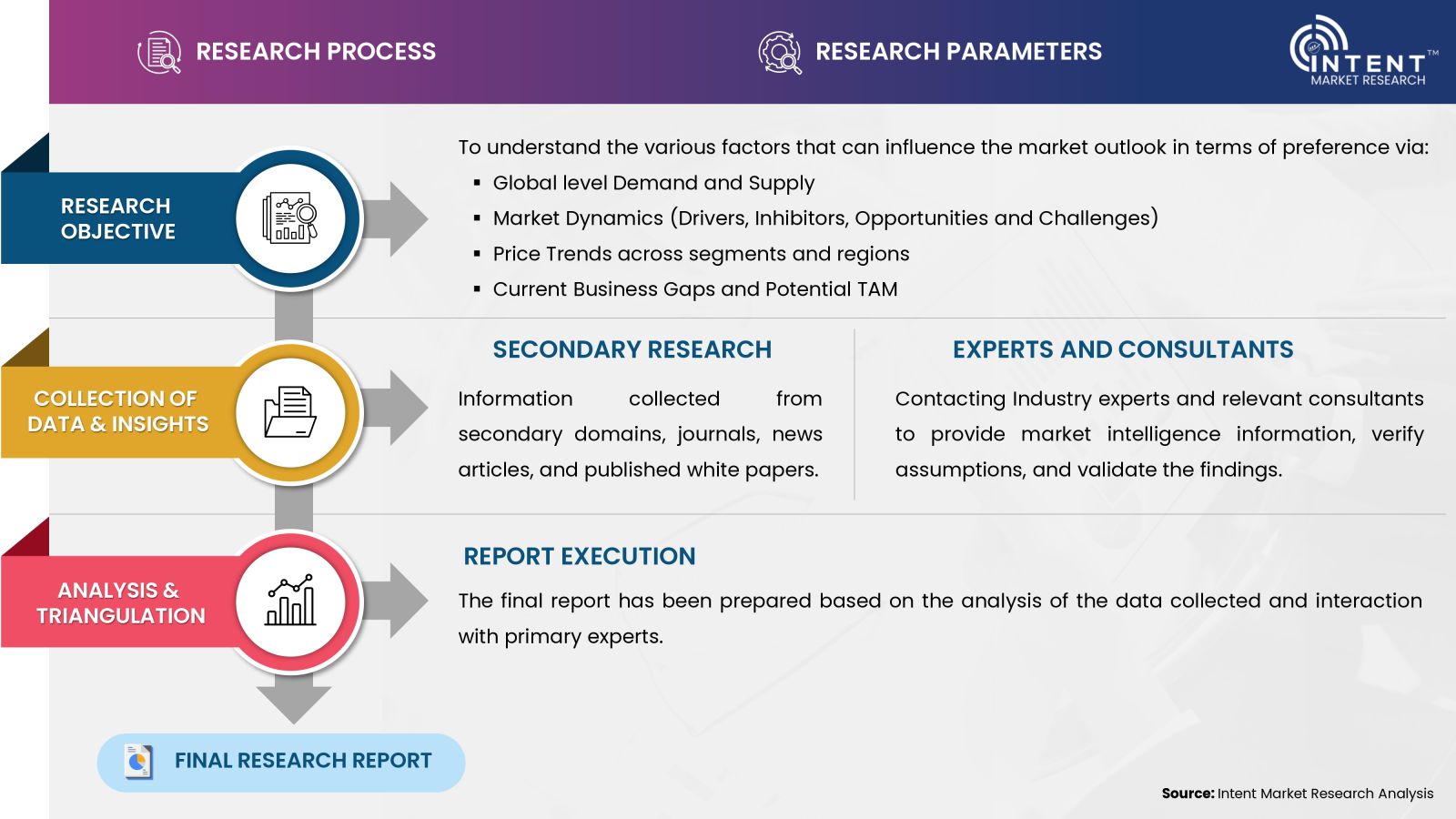
- Secondary Research Approach: During the initial phase of the research process, we acquire and accumulate extensive data continuously. This data is carefully filtered and validated through a variety of secondary sources.
- Primary Research Approach: Following the consolidation of data gathered through secondary research, we initiate a validation process to verify all the market numbers, assumptions and validate the findings by engaging with subject matter experts.
Data Collection, Analysis and Interpretation:
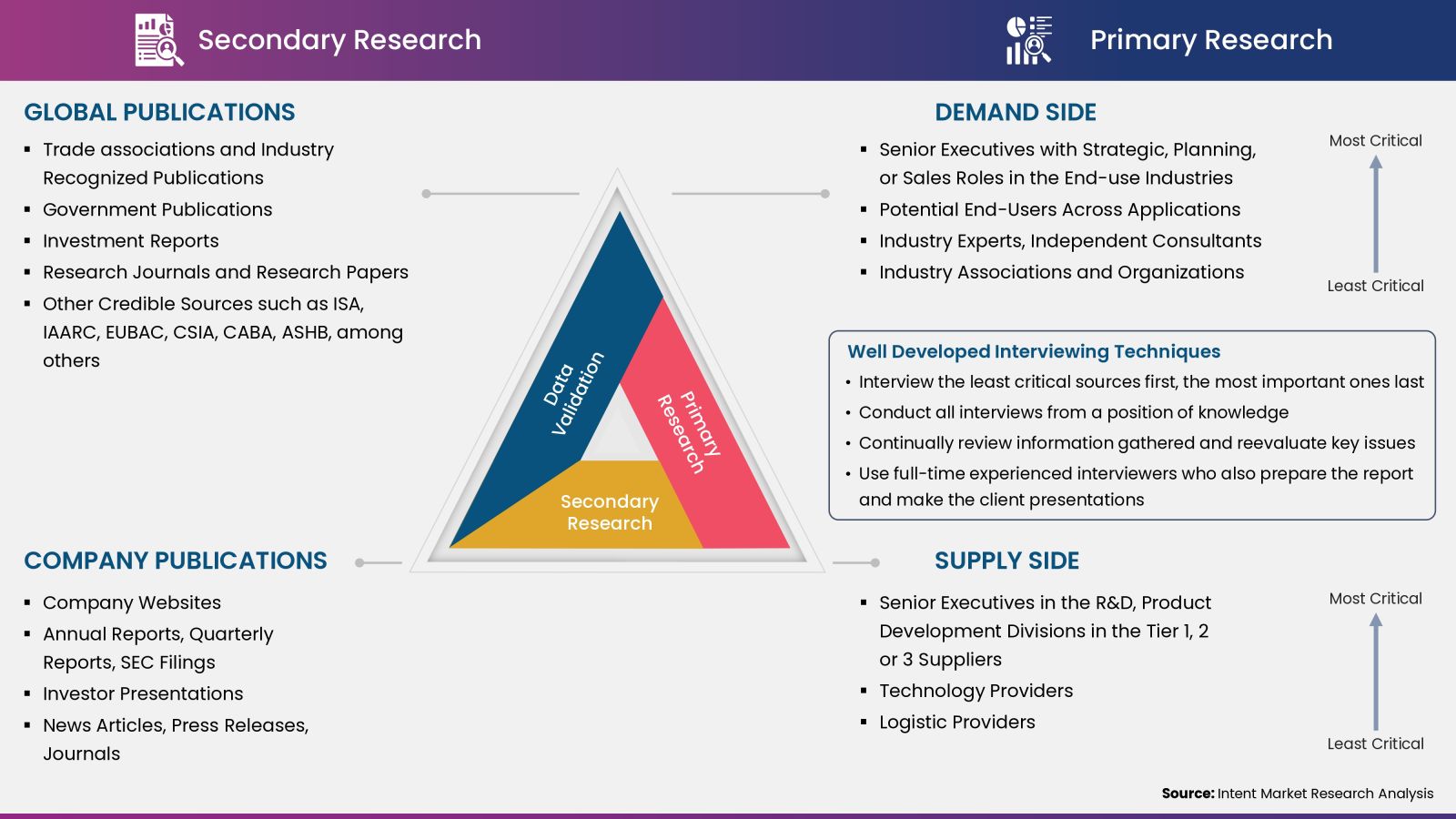
Research Methodology
Our market research methodology utilizes both top-down and bottom-up approaches to segment and estimate quantitative aspects of the market. We also employ multi-perspective analysis, examining the market from distinct viewpoints.
